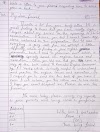 English grammar
English grammar
Covid-19 Lockdown Essay | Essay writing in English
Essay Writing on COVID-19 Lockdown 📋 Introduction : The COVID-19 pandemic, which …
Deep Water Class 12 Important Questions and Answers Introduction to Deep Water "…
 English grammar
English grammar
Essay Writing on COVID-19 Lockdown 📋 Introduction : The COVID-19 pandemic, which …


Social Plugin